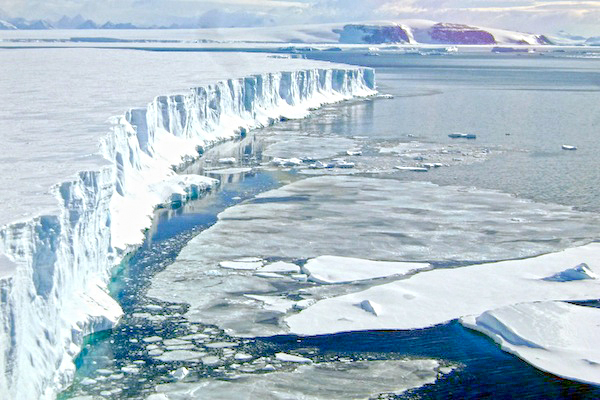If a couple of new ice studies are only partly right, we face massive disruption from sea level rise within decades.

The Larsen B ice shelf, off the east coast of the Antarctic Peninsula, in 2008. The coastal fringe of the ice sheet that covers Antarctica often extends many kilometres out over the Southern Ocean in huge floating platforms hundreds of metres thick, called ice shelves. The Larsen B ice shelf used to be over 11,500 square kilometres in area, but two-thirds of that disappeared within six weeks in a spectacular collapse in 2002. PHOTO Mariano Caravaca/Reuters/Landov
Are melting polar ice sheets as stable as we think, or have we missed something? Could we be facing rapid sea-level rise within a few decades?
Scientific debate about this has picked up in the wake of the March publication of two major research papers by scientists from the US, France, Germany and China.
A paper by James Hansen and 18 other climatologists in the open-access science journal Atmospheric Chemistry and Physics examined ancient climate change to assess how that compares with today’s melting of Greenland and Antarctic ice sheets.
It argues that during this century, ice sheet meltwater spreading over parts of the Southern Ocean and the North Atlantic will increase the temperature variation between these cooler parts and warming regions, resulting in more violent storms.
The meltwater layer also acts as a transparent lid on warming ocean waters undermining polar ice sheets sitting on bedrock below sea level. The paper’s startling prediction is that consequent disintegration could bring several metres of sea level rise within 150 years and possibly by 2070.
A paper published last week in the science journal Nature, also examining past rapid changes, looked at how the Antarctic ice sheet might react to warming of atmosphere as well as ocean, and reached similarly disturbing conclusions.
US scientists Robert DeConto and David Pollard studied the puzzle of how the massive Antarctic ice sheet shed large amounts of ice over relatively short time-frames in prehistoric warming events.
Their modelling showed that if today’s high carbon emissions continue, warmer air would add to the impact of warming seas. Fracturing ice shelves and coastal cliffs would bring rapid ice loss and contribute “more than a metre of sea-level rise by 2100”.
Both conclusions are well up on findings in the 2014 Intergovernmental Panel on Climate Change report, which says that unabated emissions will bring somewhere between half and one metre of sea level rise this century – with the caution that future ice sheet modelling may push that figure higher.
If the world doesn’t cut emissions significantly, coastal maps will become obsolete beyond 2100 as ice sheets continue to melt. The IPCC predicts seas will be 7m higher by 2500; DeConto and Pollard put the figure at “more than 15 metres”.
IPCC reports, which appear every six or seven years, range across all scientific literature and are heavily reviewed. Such reviewing, says Hansen in a concurrent article about science publishing, reflects a strong and potentially dangerous tendency to “scientific reticence”.
Hansen warns that a kind of “self-censorship” in the scientific community is making global warming seem less dangerous than it really is. Inertia both in the climate system and in the rate at which we address our emissions puts humanity in danger of passing points of no return.
John Church is a senior CSIRO oceanographer, a globally-acknowledged authority on sea level, and a leading figure in the huge assembly of scientists which put together the IPCC report.
Church is cautious about the findings in the new papers, an approach that might be seen as scientific reticence. But importantly he doesn’t dismiss them out of hand.
For 2000 years the global average sea level stayed the same, so people came to think it would never change. Then around 1880 it began rising, around a millimetre a year, increasing to 2 mm a year over last century. In the past 25 years it’s risen by over 3 mm a year.
Even conservative projections for 2100, discussed by Church in The Conversation last week, leave it “entirely possible” that by the end of the century sea level will be rising more than three times faster than it is today – a rate not seen for 10,000 years.
Things will be bad enough if sea level rise this century is at the low end of projections. But all current sea-level research points in just one direction: higher.
The speed of change is crucial. We’re still getting used to a few centimetres of rise in a decade. A sudden jump of many centimetres would cause unprecedented disruption along all our coasts, where most people live. In short, near-total disaster.
